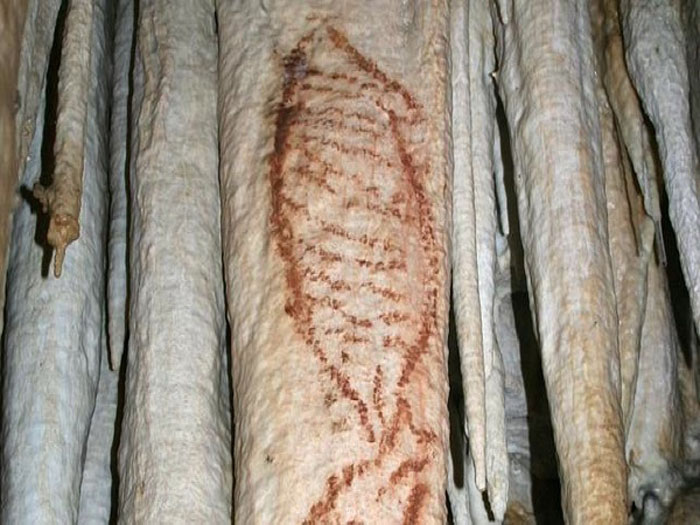Gadgets & Science
Source:zestradar.com
Humans have been practicing various art forms since the very first time they were able to hold a chisel or dip their hands into some kind of paint. The methods they used were various and the themes of their art ranged from daily occurrences like hunting to more complex ones that depicted their beliefs and relationship with the world around them. From stone engravings and ivory carvings to clay figurines and wall paintings, here are 10 oldest pieces of human art ever discovered.
Oldest prehistoric rock art: Bhimbetka Cave Cupules
Cupules (or cup-marks) are depressions cut into rock horizontally and vertically. This is probably the most ancient art form practiced by humans and it is still used by some aboriginal cultures of Australia. The oldest rock art of such kind was found at the Bhimbetka Caves of central India. Along with similar cupules from the newly discovered Daraki-Chattan cave, they are believed to be 290,000 years old! Yet the carbon analysis hasn’t been done yet, so they may actually be much older than that (some suggest they originated around 700,000 BCE).

Oldest sculpture: Venus of Berekhat Ram
While the Venus of Hohle Fels, a figurine made of mammoth ivory found in a Hohle Fels cave in Germany, is vastly considered the oldest such figurine in the world – it was created 40,000 years ago. Yet recently there’s been a new discovery in the Golah Heights in Israel. The newly discovered sculpture was called Venus of Berekhat Ram and it is believed to be more ancient that the one from Hohle Fels. It barely resembles a female form, yet archaeologists believe it was altered by human hand at least to some degree. The age of the figurine is somewhere between 233,000 and 800,000, which is mind-boggling to say the least.

Oldest eggshell engravings: Diepkloof Rock Shelter in South Africa
Diepkloof Rock Shelter in South Africa is home to 270 ostrich egg fragments decorated with pigments and engravings. Eggshells are among the first materials used by prehistoric people to preserve their art. Their age is somewhere around 60,000 BCE!

Earliest European cave drawings: caves of Nerja in Malaga
Until recently it was believed that no cave drawings were produced by Neanderthals as they were deemed incapable of such thing. It all changed when the researchers working in the caves of Nerja in Malaga, Spain, found paintings that predated the famous Chauvet cave art found in France. These newly found drawings depicted seals, a source of food for local Neanderthals at that time, and were dated to be 42,300–43,500 years old.

The oldest handprint art: Sulawesi Caves of Indonesia
The Sulawesi Caves of Indonesia are home to the oldest hand painting on Earth – it was dated to be at least 39,900 years old according to uranium-series dating of mineral coating. Radiocarbon-dating may reveal it to be even older than that! The painting was created simply by blowing ochre paint around the hand pressed to a wall. Kids still use this trick nowadays!

Oldest ivory figurines: Swabian Jura plateau in Germany
The Swabian Jura plateau in Germany is a source of many ancient findings. In 2007, archaeologists stumbled upon several ivory figurines around 35,000 years old! All in all there were 5 carvings depicting lion, mammoths, and a few pieces that were impossible to identify. Radiocarbon dating indicated these carvings were created between 30,000 and 36,000 years ago. Which makes them the oldest carvings on Earth!

Earliest ceramic art: The Venus of Dolni Vestonice
The Venus of Dolni Vestonice was found in South Moravia, Czechoslovakia, along with a few other carvings and broken pieces. Archaeologists believe it was created between 22,000 and 28,000 years ago, making it the oldest clay figurine made of fire-baked clay. What makes this figurine special is the fact that fire-baked clay wasn’t supposed to be used for another 14,000 years. The Venus of Dolni Vestonice contained a fingerprint belonging to a prehistoric child of 5-14 years!

The earliest landscape painting: The Catalhoyuk mural
Ancient people always had a purpose to the drawings they made, yet this may be the very first that was created merely for art. Found by James Melaart in Catalhoyuk, a large Stone Age town located in Turkey, the painting is believed to depict a volcano eruption and a city map. Other researchers suggest it’s just a leopard skin and some abstract shapes nearby. The painting was created somewhere around 6,000 – 8,000 BC, making it the oldest landscape art as of today.

The most ancient illuminated manuscript: monastery Tigray, Ethiopia
Illuminated manuscripts were created by Christian scribes during medieval times. Perhaps understanding the value of a handwritten book filled with knowledge, these scribes started creating special radiant manuscripts adorned with beautiful calligraphy, putting precious stones on the covers and using various hues to create illustrations in the book. One such manuscript was found in a monastery in Ethiopia. Radiocarbon dating revealed it was created around A.D. 330–650, making it the oldest such manuscript we know of today.

Earliest oil painting: Buddhist Bamiyan caves
Bamiyan caves, located in Afghanistan, are home to a spectacular Buddhist mural that appears to have an oil-based binder. Researchers believe it was made like this in order to preserve the painting, so it could hold on the rocky surface of the cave. Various samples of artwork from Bamiyan Valley revealed the same! They used oil-based paints to create the artwork, which dates back to the 7th century. The mural depicts Buddhas and various Hindu deities adorned with beautiful ornate designs and swirling patterns.

